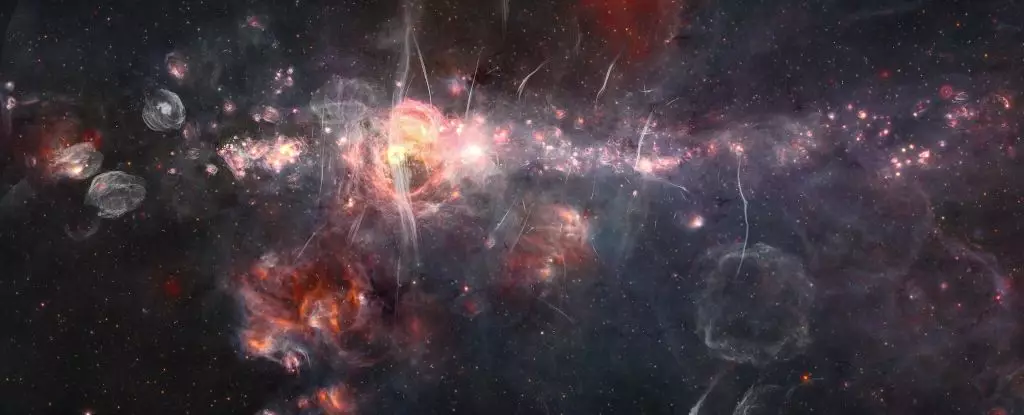The center of the Milky Way galaxy, while often overshadowed by the more tranquil aspects of cosmic phenomena, reveals itself to be an astonishingly vibrant region teeming with high-energy activities. Recent discoveries have shed light on a captivating source of gamma rays, dubbed HAWC J1746-2856, which has emerged as one of the most potent cosmic accelerators identified in our galactic neighborhood. This locale stands out not just for its historic presence but for the unprecedented energy levels emanating from it, drawing the interest of astrophysicists worldwide.
The High-Altitude Water Cherenkov (HAWC) observatory, perched in the Sierra Negra mountains of Mexico, has been instrumental in recording gamma-ray emissions from this intriguing point in our galaxy. Over the span of seven years, 98 distinct gamma-ray events were documented, each sporting energy levels that exceed 100 teraelectronvolts (TeV). This discovery highlights the center of the Milky Way as an arena for extreme physical and energetic phenomena, transcending prior understandings of cosmic radiation sources in our galaxy.
At the heart of this discovery lies the concept of PeVatrons—natural particle accelerators capable of generating ultrahigh-energy cosmic rays. These enigmatic entities arise from powerful cosmic processes often associated with supernova remnants, the birth of new stars, and the magnetic fields surrounding supermassive black holes. In essence, a PeVatron accelerates charged protons and atomic nuclei to extraordinary velocities, enabling them to reach energies on the order of a trillion electronvolts.
The challenge in identifying PeVatrons stems from their rarity and the specific cosmic conditions required for their formation. As physicist Pat Harding from Los Alamos National Laboratory asserts, many of the processes leading to these accelerators occur infrequently or on scales that do not align with typical galactic phenomena. Black hole mergers, for instance, are events that predominantly take place outside our galaxy and can’t be relied upon to explain the dynamics happening within it.
Gamma rays are pivotal in understanding cosmic phenomena, yet their detection poses significant complications due to their limited range within the Earth’s atmosphere. When high-energy gamma rays collide with atmospheric molecules, they produce secondary particles that cascade downwards, forming a shower detectable by specialized instruments like those found at HAWC. The observatory’s unique capabilities to capture gamma rays at teraelectronvolt energies have led to remarkable breakthroughs, including the first detection of TeV gamma rays originating from the Sun.
The specialized design of HAWC enables physicists to reconstruct the initial gamma rays responsible for the particle showers, thereby pinpointing their cosmic origins. The recent identification of HAWC J1746-2856 stands out, as it appears to be a singular point source of gamma-ray emissions from the galactic center, surpassing previous high-energy observations made in that region.
Despite the promising findings, the specific origins of HAWC J1746-2856 remain elusive. With no discernible supernova remnants adjacent to the emissions, researchers must investigate other candidates. The two prime suspects include Sagittarius A*, the supermassive black hole at the center of our galaxy, and a known, but unidentified gamma-ray source labeled HESS J1746-285, which resides near a distinctly feature referred to as the Radio Arc.
A deeper analysis reveals that the density of cosmic rays in the vicinity of HAWC J1746-2856 is greater than the average within the galaxy, suggesting an active source for the freshly accelerated protons. This pressing evidence points toward the viability of the galactic center as a dynamic arena where new cosmic phenomena are regularly occurring, with implications for our broader understanding of cosmic ray behavior.
As we stand on the brink of future observational advancements, the full story behind HAWC J1746-2856 remains tantalizingly out of reach. While the current findings confirm the presence of a PeVatron in the galactic center, they also open a Pandora’s box of new inquiries regarding cosmic rays and their origins. Observations from next-generation Cherenkov detectors promise to unlock further insights, yet for now, the inner workings of this cosmic enigma continue to captivate our scientific curiosity. The Milky Way’s center, once perceived as a mere quiet backdrop, now basks in the glory of its newfound identity as a powerhouse of cosmic events, forever changing our narrative of the universe’s complexities.


Leave a Reply